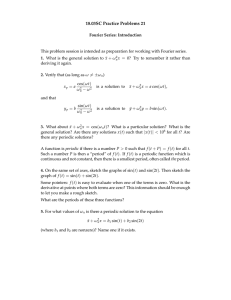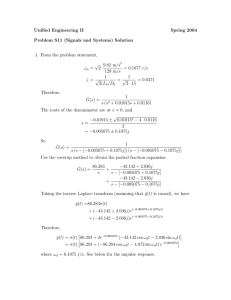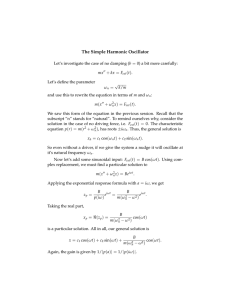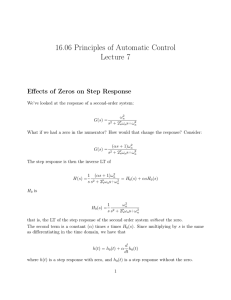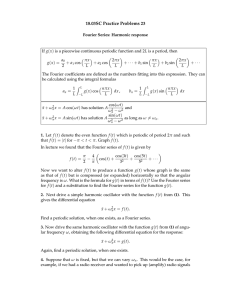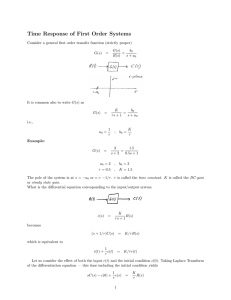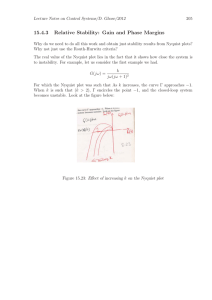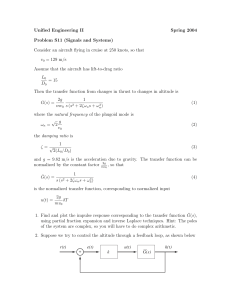Transient response specifications
advertisement
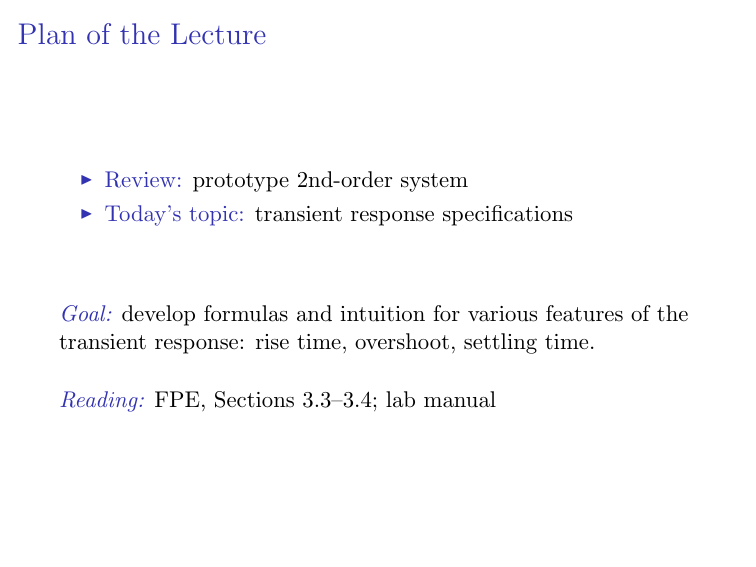
Plan of the Lecture
I
Review: prototype 2nd-order system
I
Today’s topic: transient response specifications
Goal: develop formulas and intuition for various features of the
transient response: rise time, overshoot, settling time.
Reading: FPE, Sections 3.3–3.4; lab manual
Prototype 2nd-Order System
H(s) =
ωn2
s2 + 2ζωn s + ωn2
By the quadratic formula, the poles are:
p
s = −ζωn ± ωn ζ 2 − 1
p
= −ωn ζ ± ζ 2 − 1
The nature of the poles changes depending on ζ:
I ζ >1
both poles are real and negative
I ζ =1
one negative pole
I ζ <1
two complex poles with negative real parts
s = −σ ± jωd
where
σ = ζωn , ωd = ωn
p
1 − ζ2
Prototype 2nd-Order System
H(s) =
ωn2
,
s2 + 2ζωn s + ωn2
The poles are
s = −ζωn ± jωn
ζ<1
p
1 − ζ 2 = −σ ± jωd
Im
!d = !n
!n
= ⇣!n
'
0
p
1
Note that
⇣2
Re
σ 2 + ωd2 = ζ 2 ωn2 + ωn2 − ζ 2 ωn2
= ωn2
ζωn
cos ϕ =
=ζ
ωn
2nd-Order Response
Let’s compute the system’s impulse and step response:
H(s) =
I
ωn2
ωn2
=
s2 + 2ζωn s + ωn2
(s + σ)2 + ωd2
Impulse response:
h(t) = L −1 {H(s)} = L −1
=
I
Step response:
ωn2 −σt
e
sin(ωd t)
ωd
(ωn2 /ωd )ωd
(s + σ)2 + ωd2
(table, # 20)
σ 2 + ωd2
H(s)
L −1
= L −1
s
s[(s + σ)2 + ωd2 ]
σ
= 1 − e−σt cos(ωd t) +
sin(ωd t)
(table, #21)
ωd
2nd-Order Step Response
H(s) =
ωn2
ωn2
=
s2 + 2ζωn s + ωn2
(s + σ)2 + ωd2
−σt
−→
u(t) = 1(t)
y(t) = 1 − e
where σ = ζωn and ωd = ωn
yHtL
σ
sin(ωd t)
cos(ωd t) +
ωd
p
1 − ζ 2 (damped frequency)
The parameter ζ is called
the damping ratio
1.5
I
ζ > 1: system is
overdamped
I
ζ < 1: system is
underdamped
I
ζ = 0: no damping
(ωd = ωn )
1.0
Ζ=0.1
0.5
Ζ=0.9
Ζ=1
2
4
6
8
10
12
14
t
2nd-Order Step Response
H(s) =
ωn2
ωn2
=
s2 + 2ζωn s + ωn2
(s + σ)2 + ωd2
σ
y(t) = 1 − e−σt cos(ωd t) +
sin(ωd t)
ωd
p
where σ = ζωn and ωd = ωn 1 − ζ 2 (damped frequency)
u(t) = 1(t)
−→
We will see that the parameters ζ and ωn determine certain
important features of the transient part of the above step
response.
We will also learn how to pick ζ and ωn in order to shape these
features according to given specifications.
Transient Response Specifications: Rise Time
Let’s first take a look at 1st-order step response
a
,
a>0
H(s) =
(stable pole)
s+a
DC gain = 1 (by FVT)
Step response:
H(s)
a
1
1
=
= −
s
s(s + a)
s s+a
−1
y(t) = L {Y (s)} = 1(t) − e−at
Y (s) =
yHtL
1.0
0.8
Rise time tr : the time it
takes to get from 10% of
steady-state value to 90%
0.6
0.4
0.2
rise time tr
0.5
1.0
1.5
2.0
t
Rise Time
Step response: y(t) = 1(t) − e−at
yHtL
1.0
0.8
Rise time tr : the time it
takes to get from 10% of
steady-state value to 90%
0.6
0.4
0.2
rise time tr
0.5
1.0
1.5
2.0
t
In this example, it is easy to compute tr analytically:
ln 0.9
a
ln 0.1
−at0.9
−at0.9
1−e
= 0.9
e
= 0.1
t0.9 = −
a
ln 0.9 − ln 0.1
ln 9
2.2
tr = t0.9 − t0.1 =
=
≈
a
a
a
1 − e−at0.1 = 0.1
e−at0.1 = 0.9
t0.1 = −
Transient Response Specs
Now let’s consider the more interesting case: 2nd-order response
ωn2
ωn2
=
s2 + 2ζωn s + ωn2
(s + σ)2 + ωd2
p
where σ = ζωn ωd = ωn 1 − ζ 2
(ζ < 1)
H(s) =
Im
!d = !n
!n
= ⇣!n
Step response:
'
y(t) = 1 −
0
e−σt
p
1
⇣2
Re
σ
cos(ωd t) +
sin(ωd t)
ωd
Transient-Response Specs
y(t) = 1 −
Step response:
yHtL
1.4
e−σt
σ
cos(ωd t) +
sin(ωd t)
ωd
Mp
1.2
1.0
0.8
0.6
0.4
0.2
! n tr
2
! n ts
! n tp
4
6
8
10
12
14
wn t
I
rise time tr — time to get from 0.1y(∞) to 0.9y(∞)
I
overshoot Mp and peak time tp
I
settling time ts — first time for transients to decay to
within a specified small percentage of y(∞) and stay in
that range (we will usually worry about 5% settling time)
Transient-Response (or Time-Domain) Specs
yHtL
1.4
Mp
1.2
1.0
0.8
0.6
0.4
0.2
! n tr
2
! n ts
! n tp
4
6
8
10
12
14
wn t
Do we want these quantities to be large or small?
I
tr
small
I
Mp
I
tp
small
I
ts
small
small
Trade-offs among specs: decrease tr −→ increase Mp , etc.
yHtL
1.4
Mp
1.2
1.0
0.8
0.6
0.4
0.2
! n tr
2
! n ts
! n tp
4
6
8
10
12
14
wn t
Formulas for TD Specs: Rise Time
yHtL
1.4
Mp
1.2
1.0
0.8
0.6
0.4
0.2
! n tr
2
! n ts
! n tp
4
6
8
10
12
14
wn t
Rise time tr — hard to calculate analytically.
Empirically, on the normalized time scale (t → ωn t), rise times
are approximately the same
wn tr ≈ 1.8
So, we will work with tr ≈
(exact for ζ = 0.5)
1.8
ωn
(good approx. when ζ ≈ 0.5)
Formulas for TD Specs: Overshoot & Peak Time
yHtL
1.4
Mp
1.2
1.0
0.8
0.6
0.4
0.2
! n tr
2
! n ts
! n tp
4
6
8
10
12
14
wn t
tp is the first time t > 0 when y 0 (t) = 0
σ
−σt
y(t) = 1 − e
cos(ωd t) +
sin(ωd t)
ωd
2
σ
0
y (t) =
+ ωd e−σt sin(ωd t) = 0 when ωd t = 0, π, 2π, . . .
ωd
so tp =
π
ωd
Formulas for TD Specs: Overshoot & Peak Time
yHtL
1.4
Mp
1.2
1.0
0.8
0.6
0.4
0.2
! n tr
2
! n ts
! n tp
4
6
We have just computed tp =
8
10
12
14
wn t
π
ωd
To find Mp , plug this value into y(t):
π
σ
π
− σπ
ωd
Mp = y(tp ) − 1 = −e
cos ωd
+
sin ωd
ωd
ωd
ωd
!
σπ
πζ
= exp −
= exp − p
— exact formula
ωd
1 − ζ2
Formulas for TD Specs: Settling Time
yHtL
1.4
Mp
1.2
1.0
0.8
0.6
0.4
0.2
! n tr
2
! n ts
! n tp
4
6
8
10
12
14
wn t
|y(t0 ) − y(∞)|
ts = min t > 0 :
≤ 0.05 for all t0 ≥ t (here,
y(∞)
y(∞) = 1)
σ
cos(ωd t) + ωd sin(ωd t)
−σt |y(t) − 1| = e
here, e−σt is what matters (sin and cos are bounded between
ln 0.05
3
±1), so e−σts ≤ 0.05
this gives ts = −
≈
σ
σ
Formulas for TD Specs
H(s) =
σ 2 + ωd2
ωn2
=
s2 + 2ζωn s + ωn2
(s + σ)2 + ωd2
1.8
ωn
π
tp =
ωd
tr ≈
Mp = exp − p
ts ≈
3
σ
πζ
1 − ζ2
!
TD Specs in Frequency Domain
We want to visualize time-domain specs in terms of admissible
pole locations for the 2nd-order system
H(s) =
σ 2 + ωd2
ωn2
=
s2 + 2ζωn s + ωn2
(s + σ)2 + ωd2
where σ = ζωn
p
ωd = ωn 1 − ζ 2
Step response: y(t) = 1 − e−σt cos(ωd t) +
Im
!d = !n
!n
= ⇣!n
'
0
p
1
σ
ωd
sin(ωd t)
⇣2
Re
ωn2 = σ 2 + ωd2
ζ = cos ϕ
Rise Time in Frequency Domain
Suppose we want tr ≤ c
tr ≈
1.8
≤c
ωn
=⇒
(c is some desired given value)
ωn ≥
1.8
c
Geometrically, we want poles to lie in the shaded region:
Im
!n =
0
1.8
c
Re
(recall that ωn is the magnitude of the poles)
Overshoot in Frequency Domain
Suppose we want Mp ≤ c
πζ
!
Mp = exp − p
≤c
1 − ζ2
|
{z
}
— need large damping ratio
decreasing function
Geometrically, we want poles to lie in the shaded region:
Im
'
0
Re
ζ
ω ζ
pn
p
=
2
1−ζ
ωn 1 − ζ 2
σ
=
= cot ϕ
ωd
— need ϕ to be small
Intuition: good damping →
good decay in 1/2 period
Settling Time in Frequency Domain
Suppose we want ts ≤ c
ts ≈
3
≤c
σ
=⇒
σ≥
3
c
Want poles to be sufficiently fast (large enough magnitude of
real part):
Im
=
3
c
0
Re
Intuition: poles far to the
left → transients decay
faster → smaller ts
Combination of Specs
If we have specs for any combination of tr , Mp , ts , we can easily
relate them to allowed pole locations:
Im
0
Re
The shape and size of the
region for admissible pole
locations will change
depending on which
specs are more severely
constrained.
This is very appealing to engineers: easy to visualize things, no
such crisp visualization in time domain.
But: not very rigorous, and also only valid for our prototype
2nd-order system, which has only 2 poles and no zeros ...
